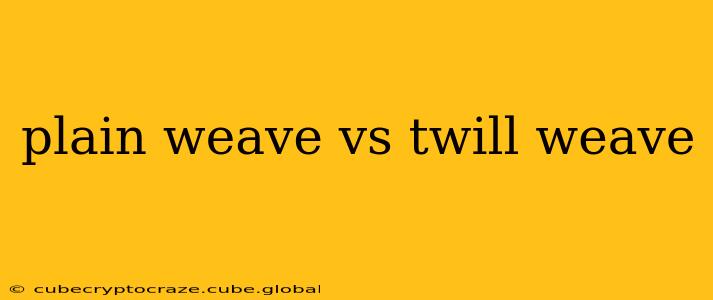Choosing the right fabric for your project often hinges on understanding the underlying weave structure. Two of the most common and fundamental weaves are plain weave and twill weave. While seemingly simple, these weaves offer vastly different properties influencing drape, durability, and overall aesthetic. This guide delves into the key differences between plain weave and twill weave, helping you make informed decisions for your next sewing or design project.
What is Plain Weave?
Plain weave, also known as tabby weave, is the simplest and most basic fabric construction. It's characterized by a one-under, one-over interlacing pattern of warp and weft yarns. This means each weft yarn passes over one warp yarn and then under the next, repeating this pattern across the width of the fabric. Think of it like a checkerboard pattern – simple, yet effective.
Key Characteristics of Plain Weave:
- Appearance: Has a relatively even, balanced surface. The warp and weft yarns are equally visible.
- Durability: Generally less durable than twill weave, especially when subjected to stress. More prone to snags and tears.
- Drape: Can range from crisp and stiff (like linen) to soft and pliable (like cotton lawn), depending on the yarn type and finishing processes.
- Examples: Cotton shirting, linen, muslin, cheesecloth, percale.
What is Twill Weave?
Twill weave is created by passing the weft yarn over and under two or more warp yarns in a diagonal pattern. This "float" of the yarn over multiple yarns creates the characteristic diagonal lines, also known as wales, that define twill fabrics. The direction of this diagonal can change depending on the type of twill.
Key Characteristics of Twill Weave:
- Appearance: Displays distinctive diagonal lines (wales) running across the fabric. The angle of these lines varies based on the twill structure.
- Durability: Stronger and more durable than plain weave due to the interlocking pattern of yarns. More resistant to snags and tears.
- Drape: Generally has a more substantial drape than plain weave, offering a smoother, less prone to wrinkling appearance.
- Examples: Denim, gabardine, serge, herringbone.
Plain Weave vs. Twill Weave: A Side-by-Side Comparison
| Feature | Plain Weave | Twill Weave |
|---|---|---|
| Interlacing | One-under, one-over | One-over, two or more under (diagonal) |
| Appearance | Even, balanced surface | Diagonal lines (wales) |
| Durability | Less durable | More durable |
| Drape | Varies greatly depending on the yarn used | Generally smoother, less prone to wrinkling |
| Texture | Smoother or slightly textured | More textured, often has a noticeable diagonal |
| Strength | Less strong | Stronger |
What are the advantages of plain weave?
Plain weave boasts several advantages:
- Breathability: Its open structure allows for excellent air circulation, making it ideal for warmer climates or garments requiring breathability.
- Versatility: Its simple structure lends itself to a wide range of fiber types and finishes, offering diverse textures and aesthetics.
- Ease of dyeing and printing: The accessible surface of plain weave fabrics makes them easier to dye and print.
What are the advantages of twill weave?
Twill weave offers a unique set of advantages:
- Durability: Its diagonal structure provides superior strength and resilience, making it suitable for workwear and other demanding applications.
- Water resistance: The close interlacing of yarns in twill weave can provide better water resistance than plain weave.
- Warmth: The thicker, more complex structure of twill weave can offer better insulation and warmth than plain weave.
Which weave is best for which projects?
The best weave depends entirely on the intended use and desired properties:
- Plain weave: Ideal for lightweight garments like blouses, dresses, and bedding. Also suitable for applications needing breathability, such as handkerchiefs or summer clothing.
- Twill weave: Suitable for garments requiring durability and warmth, such as jeans, trousers, and coats. Also excellent for applications needing water resistance.
How can I tell the difference between plain weave and twill weave?
Identifying the weave is simple: look closely at the fabric. Plain weave will show a straight, even, and balanced pattern. Twill weave will exhibit clear diagonal lines. You can even run your fingers across the fabric; twill will often feel slightly more textured than plain weave.
This comprehensive guide provides a clear understanding of the differences between plain and twill weaves, enabling you to choose the most suitable fabric for your next creative endeavor. Remember to consider factors like the desired drape, durability, and overall aesthetic when selecting a fabric.
